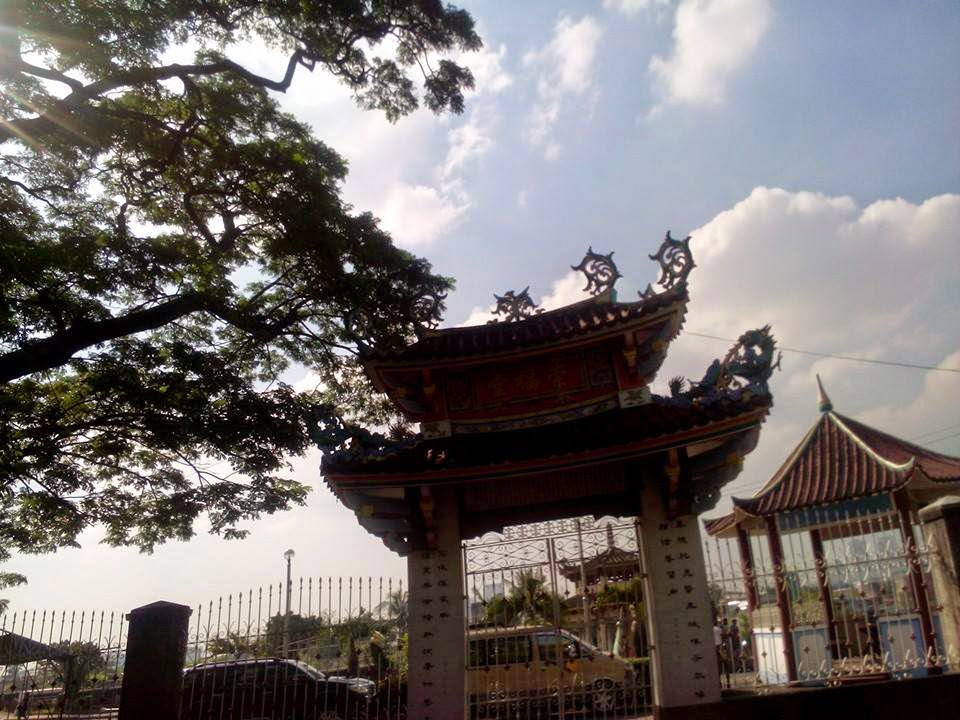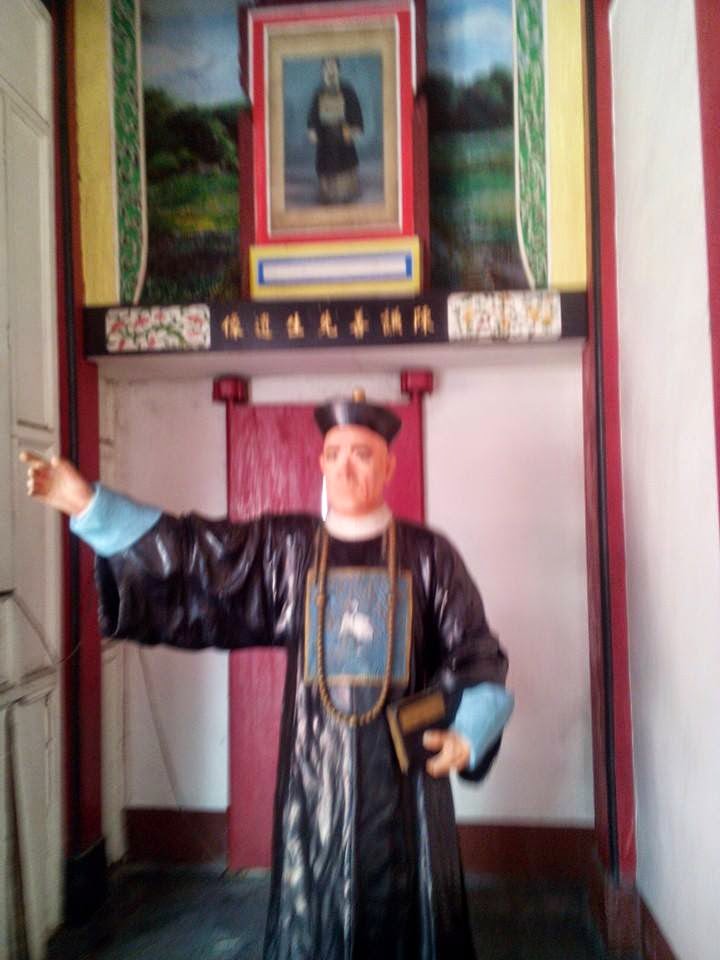 |
| Arch at the Manila Chinese Cemetery credits to panoramio.com |
There is a Chinese Cemetery which was founded in the mid-1850's by Lim Ong
and Tan Quien Sien for Chinese who were not permitted, at that time, to be buried
in the Catholic cemeteries. its called 華僑義山 , or Manila Chinese Cemetery
The cemetery covers 54 hectares of land. On Saturday, Oct 25, friend and tour
guide Lawrence Chan conducts another series of his successful but stressful free
guided tours called Walk with Chan.(a similar cemetery tour can be found here)
We were told that it will be a half day tour.I was with John Paraiso, Philip Reyes,
Ralph Soriano
from 630am to lunchtime. tiring, but RARE. and for this alone it is quite worth
the travel to this unique chinese cemetery.
If you want to see exotic and historic mould into one, Join me. as I narrate
our experiences on Oct 25.
Lawrence narrates to us, as he uncovers for us, the secret of this Chinese Cemetery,
whereby it is said that the living standard of the dead are even better than that of
the living. Toilets, sinks, chairs, tables, chandeliers, aircon, can be found in some
of the mausoleums.
Upon entering the south gate, you will see the main alley. Lawrence dubbed
"Millionaire's Lane".
As in life, so it is in death for Manila’s wealthy Chinese citizens, who are buried
with every modern convenience in the huge Chinese Cemetery. There are
mausoleums with crystal chandeliers, air-con, hot and cold running water,
kitchens and flushing toilets. only in Manila? yes.
This is the where the richest dead stays. The lease is for only 25 years, and cost
up to millions of pesos. a luxury during the old days.
here in Chinese Cemetery, as well as in La Loma, you would see the style and
ornamentation of the memorials are Gothic and Neo-classic to Art Deco.
We found tombs and mausoleums that make the cemetery-scape interesting like those
that show years of exposure to the natural elements.
this is the chinese 'city of the dead' as 70% of funerary architecture resembles chinese
temples and depicts parts of grand chinese residence 'back home'.
Visiting the Manila Chinese Cemetery is like stepping into another dimension in time.
the complex is generally clean and quiet. (unlike Manila North).
 |
| tortoise tomb |
There is a famous tortoise tomb here. In Chinese culture, tortoise is a auspicious symbol of longevity, but for the Filipino non-Chinese, they dislike tortoise, saying it is slow and clumsy.
The place boasts of interesting mausoleums with varied chinese architecture.
One of the reasons why Chinese architecture was easily accepted and integrated
into Filipino Architecture would be their love of adornment and details.
APOLINARIO MABINI
 |
| APOLINARIO MABINI TOMB |
History and culture are captured in the cemeteries of Manila, some dating as far back as the Spanish colonial era. Here are some more pics of what you see inside:
CHINESE 宗福堂 temple
Chong Hock Tong Temple
Chong Hock Tong Temple
 |
This temple is different from the typical Chinese temples around since it was built in the mid 1800s.
|
 |
| What you will see here is the architecture similar to the ones found in the Fujian province. |
宗福堂
if La Loma has the old Chapel of St. Pancratius, the Manila Chinese has theChong Hock Tong Temple, Built in the 1878, and is considered the oldest Chinese
temple in Manila. Though not as elaborate, the architecture is still inspired from those in
Fujian with their colorful red details of chinese ornaments.
The Cemetery has sites with memorials for these war patriots. one which honors
eight staff members of the Chinese consulate who were arrested and tortured in
Manila in January 1942 by the invading Japanese Army and were executed weeks
later, on April 17, for refusing to collaborate. The execution took place in the
Chinese Cemetery, in front of the graves that had already been dug.
kwang son young Japanese Memorial was erected in honor of community leaders
who were executed by the Japanese during World War II.
the Philippine Chinese Anti-Japanese Guerrilla Force, popularly known as
“Wah Chi.” This memorial honors those local Chinese guerrillas who fought
the Japanese invaders in Central Luzon alongside guerillas of Hukbalahap.
 |
| The memorial is located just in the rear of the famous Lee See Tong Martyr's Hall inside the Manila Chinese Cemetery |
These Chinese Cemetery memorials, still well kept but hardly visited. Besides
the memorial to the Chinese consular staff, there is a Martyrs’ Hall, put up
in memory of nine local Chinese businessmen who were executed two days before
the Chinese consular staff, also at the Chinese Cemetery.

The Manila Chinese Cemetery is the second oldest cemetery in Manila after La Loma
Cemetery and was designated as the resting place for the Chinese citizens who were
denied burial in Catholic cemeteries during the Spanish colonial period.
MEMORIALS :
 |
If you are into recent history, then you should be glad to see the Liat See Tong or the Martyrs Hall in the Manila Chinese Cemetery.
|
numerous Chinese, Filipino and American guerrillas who fought and died in the
Philippines against Japanese invaders.
 |
Not as grand as you would expect, considering it was an honour, but still it is worth commemorating the Chinese communities’ contribution and sacrifice during the last world war.
|
 | |||
 |
| Here you can find the final resting place of the Chinese leaders executed during WWII by the Japanese. |
 |
| The Ruby Tower Memorial is inside the Chinese Cemetery |
perished during the deadly August 2, 1968 earthquake that hit Manila
 |
| dedicated to the Chinese-Filipinos who perished in the collapse of the six-storey Ruby Tower building on August 2, 1968 during an earthquake that hit Manila. |
 |
| close up shot |
 |
| It was built in 1974 |
Chinese temples, memorials and halls, all of them are unique and have their own history.
Considering that this is the second oldest cemetery in Manila and was designed for
Chinese citizens during the Spanish colonial period. and by the way, ignore the
Ghost lives in cemeteries crap! there were not seen during the tour.
Unfortunately, not many people find pleasure in visiting cemeteries. Perhaps it is the
presence of a tomb or the sight of rows upon rows of crosses and peeling statues of
weeping angels that bring horror to most.
CEMETERIES ARE CONSIDERED cities of the dead. Usually enclosed by high walls,
they remain virtual ghost towns for much of the year, their silence broken only every now
and then by funeral processions and burials.
It is only during the much-celebrated All Saints’ Day and All Souls’ Day that they buzz
with the activity of the living as those who are left behind pay their respects to the dead,
bringing with them the trappings of daily life.
But there are more to cemeteries than the pervasive somber—if eerie—atmosphere;
from an architectural standpoint, they are miniature showcases of various styles, forms
and influences. They, in fact, tell the story of architecture.
The Cemeteria Catolica de la Loma, Cemeterio Municipal de Manila or we now call as
(Manila North Cemetery) and the Chinese Cemetery in Manila house the best examples
of funerary architecture in the Philippines. Established during the dying years of the 19th
century, they have what are probably the best and richest mausoleums money can buy.
Blogs with similar topics made by Philip Reyes John Paraiso Lawrence Chan can be read by clicking on their names
Getting there
From Manila centre, take a Light Rail Transit (LRT) Line 1 station and alight at Abad Santos. From there you can take a tricycle to the cemetery south gate.
this is your LOVERBOY Dennis signing out. Happy Haloween!!!
predaking168.blogspot.com , Oct 26, 2014































No comments:
Post a Comment